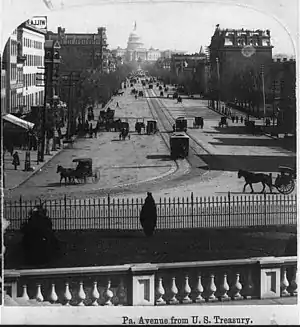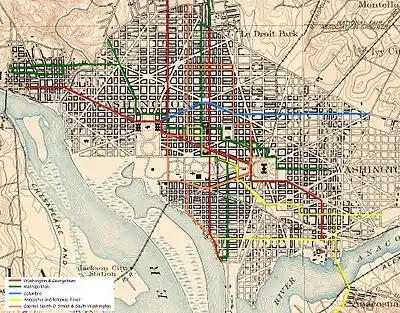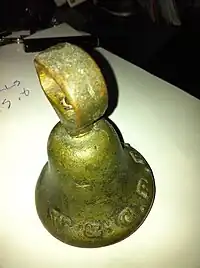Washington and Georgetown Railroad
The Washington and Georgetown Railroad Company (or Washington and Georgetown Railway Company) was the first streetcar company to operate in Washington, D.C., United States. It was incorporated and started operations in 1862, using horse-drawn cars on tracks between Georgetown and the Navy Yard. Two additional lines ran on 7th Street NW/SW and 14th Street NW. In 1890, it switched to cable cars. On September 21, 1895, the company was purchased by the Rock Creek Railway and the two formed the Capital Traction Company.

Origins
In 1852, side-bearing rail streetcar tracks were developed in New York City. Beginning in 1858, New York City businessmen began trying to bring streetcar service in Washington, D.C., where transit consisted of horse-drawn wagons (omnibuses) on several lines. On May 17, 1862, the United States Congress enacted legislation that incorporated the first Washington street car company.[1] A provision in the law authorized the Washington and Georgetown Railroad Company (or Washington and Georgetown Railway Company according to some official sources) to build three street horsecar lines.[2][3]
The first streetcar started running on Pennsylvania Avenue NW from the Capitol to the State Department on July 29, 1862. Full operations, from the Navy Yard to Georgetown on Pennsylvania Avenue NW/SE, began on October 2, 1862.[1][4] The horsecars traveled from the intersection of High Street and Bridge Street (Now Wisconsin Ave NW and M St NW) in Georgetown along Bridge Street to Pennsylvania Avenue.[2][5]
The line then traveled along Pennsylvania Avenue and passed the White House and the foot of the Capitol Building. From there it went north on 1st St NW one block, then east on B St NW/NE for two blocks, then south across the Capitol Grounds on the east side of the Capitol and back onto Pennsylvania Avenue. It then traveled southeast on Pennsylvania to 8th St SE where it turned south to the Navy Yard, stopping at M St SE and 8th St SE.[2][5]
Expansion
A second line opened on November 15, 1862. It was built along 7th Street NW from N Street NW to the Potomac River. In 1863 the 7th Street line was extended north to Boundary Street NW.[6] It expanded south to the Arsenal (now Fort McNair) in 1875.[2][7] A third line, built by 1870,[5] ran down 14th Street NW from Boundary Street NW (now Florida Avenue) to the Treasury Building.[6]
In 1877, the company built a car barn at 13th and Boundary Streets NW. From 1877-92, the company expanded the facility several times, adding a blacksmith shop in 1878.[8] The omnibus company that existed before the introduction of streetcars was forced out of business. The Washington and Georgetown line then purchased the company's stables to be used as a car barn and, much later, as machine shops.
Switch to cable cars

On March 2, 1889, the District authorized every streetcar company in Washington to switch from horse power to underground cable or to electricity provided by battery or underground wires (overhead wires were banned). The following year, companies were authorized to sell stock to pay for the upgrades. In 1892, one-horse cars were banned within the city, and by 1894, Congress began requiring companies to switch from horse power.
Immediately after the 1889 law was passed, the Washington and Georgetown began installing an underground cable system, adding five new facilities to handle the cable operations. The 7th Street line was switched to a cable car system on April 12, 1890, with 16 cars traveling on the route at 6 mph (9.7 km/h) at three-minute intervals, from 5 a.m. to 1 a.m. daily. The entire system was in operation by August 18, 1892,[1][6] with two cables pulling the cars up and down Pennsylvania Avenue NW/SE between the Navy Yard and Georgetown.
In 1892, the railroad extended its track along 14th to Mount Pleasant Street NW (now Park Road NW) and built a new barn there. It moved the cars from the barn at 13th Street and Florida Avenue NW to the new one and sold the older facility, which was converted into a printing plant.[8]
In 1893, the company built the Navy Yard Car Barn across from the Navy Yard to service the new cars.[9]
The company built two powerhouses to provide electricity for the system, one at 14th Street NW and E Street NW and the other at 7th Street SW and P Street SW. In the middle of the intersection of 14th Street NW and Pennsylvania Avenue NW, a large wheel pit was constructed.[1] On August 23, 1894, the company was authorized to extend its line on M Street NW to the Aqueduct Bridge, and build a "Union Station"—now the Georgetown Car Barn.[10]
The end of the line
By the mid-1890s, there were numerous streetcar companies operating in the District. Congress tried to deal with this fractured transit system by requiring them to accept transfers and set standard pricing and by allowing them to use one another's track. But eventually it became clear that consolidation was the best solution. On March 1, 1895, Congress authorized the Rock Creek Railway to purchase the Washington and Georgetown. It did so on September 21, 1895, forming the Capital Traction Company, the first company created during "the great streetcar consolidation" and spelling the end of the Washington and Georgetown Railroad Company as a separate entity.[11]
Notes
- Tindall, Dr. William (1918). Records of the Columbia Historical Society, Washington, D.C.: Beginning of Street Railways in the National Capital. Charlottesville, VA: Columbia Historical Society. pp. 24–118.
- United States., District of Columbia. Board of Commissioners (1896). "Capital Traction Company (Embracing the Rock Creek Railway Company and the Washington and Georgetown Railroad Company. AN ACT to incorporate the Washington and Georgetown Railroad Company. (Now the Capital Traction Company.) (May 17, 1862)". Laws relating to street-railway franchises in the District of Columbia: (Including street-railway laws enacted during the First session of the Fifty-fourth Congress). Washington, D.C.: Government Printing Office. p. 47. 12 Stat. 388. Retrieved July 23, 2021 – via Internet Archive.
Be it enacted by the Senate and House of Representatives of the United States of America in Congress assembled, That Washington Eliab Kingman, Franklin Tenney, J. J. Coombs, Sayles J. Bowen, Charles H. Upton, Henry Addison, Hallett Kilbourne, and their associates and assigns be, and they are hereby created a body corporate, under the name of the "Washington and Georgetown Railroad Company," with authority to construct and lay down a double track railway, ....
- (1) "Monday, May 19, 1862". Journal of the Senate of the United States of America: Being the Second Session of the Thirty-Seventh Congress: Begun and Held at the City of Washington: December 2, 1861: In the Eighty-Sixth Year of Independence of the United States. United States Congressional serial set. Washington, D.C.: Government Printing Office (1116): 505. 1861. OCLC 59107615. Retrieved July 23, 2021 – via Google Books.
A message from the President of the United States, by Mr. Nicolay, his secretary:
Mr. President: The President of the United States approved and signed, on the 17th instant, the following acts:
S. 178, An act to incorporate the Washington and Georgetown Railway Company. ....
(2) United States., District of Columbia. Board of Commissioners (1896). "AN ACT to amend an act entitled "An act to incorporate the Washington and Great Falls Electric Railway" (August 23, 1894)". Laws relating to street-railway franchises in the District of Columbia: (Including street-railway laws enacted during the First session of the Fifty-fourth Congress). United States 54 Cong. 1. Sess. H. Doc.423. Washington, D.C.: Government Printing Office. 28 Stat 492. Retrieved July 23, 2021 – via HathiTrust Digital Library.The said passenger station shall be constructed and maintained as a union passenger station, for the use of street railways only, by the Washington and Georgetown Railway Company.
- Cohen, Bob. "Washington, D.C. Railroad History". Washington, D.C. Chapter of the National Railway Historical Society. Archived from the original on 2007-01-05. Retrieved 2007-01-15.
- Johnson, A.J. (1844). "Johnson's Georgetown and the City of Washington" (map). New York: Johnson and Ward; from The New Illustrated Family Atlas. Archived from the original on February 23, 2021.
- Lee, Virginia C.; Cary Silverman (Winter 2005–2006). "Shaw on the Move Part II: Milestones in Shaw Transportation" (PDF). Shaw Main Street News. Shaw Main Streets. pp. 10–14. Retrieved 2007-01-11.
- Paul Kelsey Williams (2001–2002). "Historic Survey of Shaw East Washington, D.C." (PDF). D.C. Department of Planning. Archived from the original ([PDF]) on 2006-12-30. Retrieved 2007-01-16.
- Livingston, Mike (2000-12-08). "D.C.'s first 'flex building' built in 19th century". Washington Business Journal. Retrieved 2007-04-05.
- Kimberly Protho Williams (2003). "Capitol Hill Historic District" (PDF). The Capitol Hill Historic District. Retrieved 2007-02-06.
- (1) "AN ACT to amend an act entitled "An act to incorporate the Washington and Great Falls Electric Railway (August 23, 1894)". Laws Relating to Street-railway Franchises in the District of Columbia. United States 54 Cong. 1. Sess. H. Doc.423. Washington, D.C.: Government Printing Office. 1896. pp. 198–199. OCLC 569582480. Retrieved July 15, 2021 – via HathiTrust Digital Library.
(2) Thorn, C. W.; Baily, Thomas C. J., Jr., Civil Engineers. "Topographical map of Washington, D.C.: 1899-1900". Washington, D.C.: Globe Map & Atlas Company. LCCN 87694383. OCLC 16868694. Retrieved July 22, 2021 – via Library of Congress.{{cite web}}: CS1 maint: multiple names: authors list (link) - Tindall, William (1914). Standard History of the City of Washington from a Study of the Original Sources. Knoxville, TN: H. W. Crew & Co. pp. 414–429.
Brightwood Railway Company.
